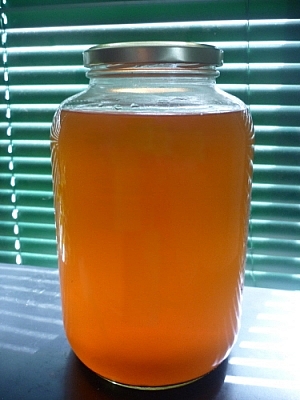There are various levels of cleaning green, from buying store-bought eco-friendly (or greenwashed) products to making your own cleaners with the purest of natural and organic ingredients.

I’m going to cover eco-friendly commercial products and specific DIY recipes later. For now, I’m focusing on the bare bones: cleaning green with vinegar, baking soda, and kombucha.
Vinegar and baking soda are the building blocks of any cleaning green routine. Kombucha, on the other hand, is a much greener alternative to vinegar, and can be used for many of the same purposes.
I’ll go through the basics of cleaning green with vinegar and baking soda first, then afterwards I’ll explain how to incorporate kombucha.
Basics of Cleaning Green With Vinegar and Baking Soda
Grist’s Umbra says:
All homebrew cleaning recipes invoke four simple ingredients: white vinegar, castile soap, baking soda, and water. Baking soda is the scrubber. Abrasive, soluble in water, and anti-fungal (or at least anti-some-fungi), baking soda requires a bit more elbow grease than chlorinated powders but leaves you with a working windpipe. Vinegar is the deodorizer and sanitizer; its mildly acidic nature is anathema to bacteria and mold. Soap is the... soap. It cleans away dirt. Don't mix it with vinegar. Castile is a mild cleansing soap, usually liquid in form. Other components of a good, healthy cleaning regimen include hot water and arm strength.
The David Suzuki Foundation’s Queen of Green says:
Acetic acid or white vinegar is a great disinfectant. It also acts as a deodorizer and cuts grease. [...] According to Canada's National Collaborating Centre for Environmental Health, the acid in vinegar crosses the cell membrane of bacteria and prompts a release of protons, which causes the cell to die. [...] Try finding stronger concentrations of vinegar at eco-friendly stores that carry a variety of green cleaning products and have refill stations... Use it for tough cleaning jobs at full strength — like that dog drool coating your car windows — or dilute it with water as needed.
However, the Queen of Green also notes that:
Mixing an acid with a base creates a (not dangerous) acid-base neutralization reaction... When [vinegar (acid) and castile soap (base)] are mixed, they neutralize each other. Have you witnessed the white curdling? That's the vinegar "unsaponifing" the castile soap, taking it back to its original oils.
Now that we know how it all works, you can check out the Queen of Green links above for some great recipes to get you on your way to cleaning green.
Recipes For Cleaning Green With Vinegar and Baking Soda
Since we’ve got the basics of cleaning green with vinegar and baking soda, we need a basic recipe for all-purpose cleaner made with vinegar and baking soda. Eartheasy suggests:
Mix a half cup vinegar and a quarter cup baking soda into 2 litres water.
Also, here are a few links to help you discover more recipes for cleaning green with vinegar and baking soda. Just remember to take a look at the Vinegar Don’ts, too!
- 10 Brilliant Uses for Vinegar — Room by Room (Queen of Green)
- 25 Tips for Naturally Cleaning with Vinegar (The Country Chic Cottage)
- 25 Ways to Naturally Clean with Baking Soda (The Country Chic Cottage)
- 50 Uses for Vinegar… Who Knew? (BabyCenter)
Cleaning Green With Kombucha Vinegar
So if vinegar is so great, why am I bringing kombucha into this? Well, for one thing, vinegar and kombucha have a lot in common.

Kombucha is usually brewed as a beverage, but if fermented for longer than usual, it becomes kombucha vinegar. Kombucha Kamp’s Kombucha Mama explains all about kombucha vinegar in Top 5 Uses for Kombucha Vinegar, but in a nutshell, that’s because it’s an acetic acid ferment, just like other types of vinegar. Kombucha Mama also does a great job of outlining the differences between kombucha vinegar and other vinegars.
Plus, kombucha vinegar makes your homemade Earth-friendly cleaning supplies allergy-friendly. For those who are intolerant to gluten, it’s important to know that white vinegar is usually made with distilled corn, and that there’s a debate surrounding whether corn should be omitted in a gluten-free diet. So for people who are highly sensitive to gluten and don’t want to take any chances, kombucha vinegar is a gluten-free alternative option to most store-bought white vinegar. And while this applies to food, I’m still talking about cleaning green here.
For some great ideas on cleaning green with kombucha vinegar, check out Kombucha Mama’s six suggestions for your household cleansing routine in Top 5 Uses for Kombucha Vinegar.
We’ve been brewing kombucha for nearly three years now, but we’ve only recently made our first batch of kombucha vinegar. We normally brew our tea for 11 days, but this batch fermented for 31 days! So far we find that kombucha vinegar cleans very well and doesn’t leave any odours. Of course, we could always harness the power of citrus fruit or essential oils to add a delightful scent.
To learn how to brew your own kombucha tea, read Kombucha 101: Benefits and Preparation and Kombucha 201: Tips and Tools, download Kombucha Mamma's free DIY Guide, and then head on over to Kombucha Kamp to order your own organic kombucha culture starter kit. They’re one hundred percent organic and packed fresh on order, so you can be sure you’re getting the best quality kombucha SCOBY.
And stay tuned for some more ideas for cleaning green! As promised above, I’ll be getting more specific soon enough.
Update: Check out my next article on cleaning green:




Search Niackery
×